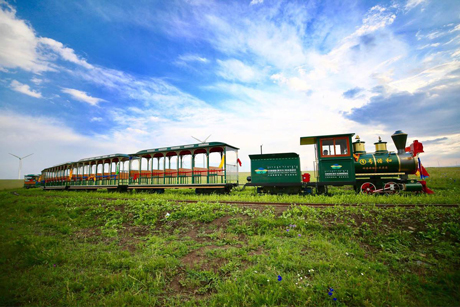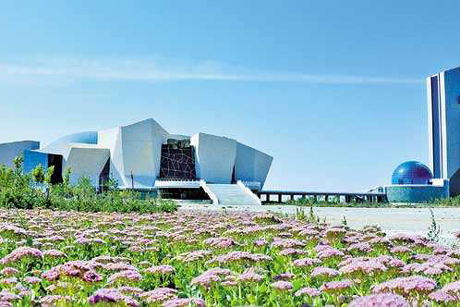CONTACT US
| +86-10-82600771 | |
| WhatsApp: +86-13911460247 | |
| Messenger: chinatournet | |
WeChat ID: callchinatour | |
This route allows you to visit the essence of the city. You can ride horses on the exotic grasslands, watch stars in the mysterious desert, and explore the history root of the city in historical relics.The best time for Inner Mongolia trip is from June to October.Huitengxile Grassland is closed on Sept 15th.
Pick up from your hotel around 19:30 and transferred to Beijing Train Station. Take overnight train K89 from Beijing to Hohhot. Soft sleeper, 4 people sharing one compartment.
Breakfast& Lunch& Dinner
You will arrive Hohhot in the early morning, and then have a mongolian flavor breakfast. After breakfast, you will be driven to the Huitengxile Grassland.
After lunch, there are various marvelous activities waiting for you, such as enjoying the horse-riding, making sacrifice to Aobao, visiting herdsman’s family, tasting dairy product and the hand-grasping mutton, watching the wrestling, Mongolian songs and dances by the campfire at night.
In the evening, the gorgeous sunset will go down from the grassland to the horizon. Immersed in such enjoyable landscape, you will stay in the yurt at night, which situated in the grassland.

Huitengxile Grassland

Huitengxile Grassland
Aobao: The most common and grand sacrificial activity of the Mongolians is the sacrificing of Aobao. Aobao means heaps of stones. Aobao is normally set up in hills and mountains, it is a cone-shaped solid tower made of stone.A long pole is inserted on the top, fur or animal skin and cloth ribbons are tied on the pole end, rocks for incense are placed around.Sacrificing of Aobao is mostly held in each June, July and August. When sacrificing, the worshipper will take Hadas,mutton, fermented milk and dairy food to the Aobao. Hadas and sacrifices will be presented firstly and Lamas will chant Buddhist scriptures and the other people will worship on bended knees. Then, they will add stone or wicker to the Aobao covered with colorful silk strips and Sutra streamers. After the sacrifice, such activities as horse races, wrestling and archery will be held, the event later developed into a Nadamu meeting.
Breakfast& Lunch& Dinner
Today is a combination of a desert and grassland journey. You'd better to get up in the early morning for the breath-taking sun-rising on the grassland,then you can enjoy walking around the great grassland and the blue sky, crystal lakes, unnamed flowers.
After lunch, you will continue a trip to the Kubuqi Desert for the mysterious Resonant Sand Gorge, where you could enjoy sand-sliding, camel-riding and the sun-set on the desert.
After that, you will be escorted back to Hohhot.

Count stars on Kubuqi Desert

Resonant Sand Gorge
The Kubuqi Desert: It is one of China's eight largest deserts. Its rainfall reaches no more than around 250mm. Strong wind and spreading sand along with sparse vegetation make it an incurable cancer of the earth.Engebei means peace, luck in Mongol. It's located in the middle stretch of the Kubuqi desert. It's where the Mongol people had lived in the time past one generation after another, where green grass thrived, livestock fed in herds, and incense from temples hung around. However, human activities such as aggressive reclamation, overuse of land for grazing , plus historical wars, were later inflicted on this weak ecosystem and eventually turned it into a sand land. People living on it were forced to migrate.
Breakfast& Lunch& Dinner
After having breakfast, you will pay a visit to Hohhot——the capital city of Inner Mongolia. After lunch, you will take a tour to Dazhao Monastery, Dinosaur Museum, Five Pagoda Temple.After dinner,we will escort you to the train station to catch train K90 (21:42-7:25) back to Beijing.

Dinosaur Museum

Five Pagoda Temple
Dazhao Monastery: Dazhao Temple, 'Wuliang Si (Infinite Temple)' in Chinese, is the oldest building and the largest temple in Hohhot, Inner Mongolia. Locally, people usually refer to it as the Silver Buddha Temple (Yinfo Si) for it is here that there is a rare silver statue of Sakyamuni that measures 2.5-meter-high (8.2-foot-high).
Inner Mongolia Museum: North China's Inner Mongolia Autonomous Region, famous for its dinosaurs fossils, is planning a museum exhibiting dinosaur fossils. The museum will be located in the Eren Basin in the northern area of the autonomous region. The ten-meter high museum, which needs an investment of 20 million yuan(approximately 2.5 million U.S. dollars), will cover an area of 4,000 sq. m. The museum will arrange exhibition halls to show the life of dinosaurs and the fossil excavating process. The Eren Basin is considered by paleontologists as the tomb of dinosaurs, for it reserves various species of fossilized dinosaurs.
Five-Pagoda Temple: The Five-Pagoda Temple is situated about 200 meters to the northwest of Beijing Zoo. Its original name, the Temple of True Awakening (Zhenjuesi), was later changed to the Temple of Great Righteous Awakening (Dazhengjuesi). Today, however, it is popularly referred to as the Five-Pagoda Temple.
After arriving in Beijing in the Morning, you can arrange your own way to the airport or your hotel.
Vehicle mode: private car or MPV van(click for picture)
Tips
Inner Mongolia has extreme weathers. There is a dramatic difference in temperature between day and night. It is necessary to take some warm clothing or rent one on the spot when you travel on the grassland. It is also one of the driest regions in China. You are kindly reminded to bring hydrated and moisturizing lotion to protect your skin.
Note: